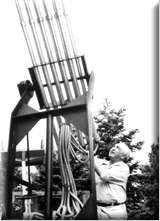Cloudbuster

A cloudbuster (or cloud buster) is a pseudoscientific device designed by Austrian psychoanalyst Wilhelm Reich (1897–1957), which Reich said could produce rain by manipulating what he called "orgone energy" present in the atmosphere.[1]
The cloudbuster was intended to be used in a way similar to a lightning rod: focusing it on a location in the sky and grounding it in some material that was presumed to absorb orgone—such as a body of water—would draw the orgone energy out of the atmosphere, causing the formation of clouds and rain. Reich conducted dozens of experiments with the cloudbuster, calling the research "Cosmic orgone engineering".[1]
Construction
A cloudbuster consists of an array of parallel hollow metal tubes which are connected at the rear to a series of flexible metal hoses which are equal or slightly smaller in diameter to the parallel tubes. Alternatively, the rear of the tubes are joined together to a single large diameter pipe and flexible metal hose. The open end of these hoses are placed in water, which Reich believed to be a natural orgone absorber. The pipes can be aimed into areas of the sky to draw energy to the ground like a lightning rod. The remains of one of Reich's cloudbusters can be found in Rangeley, Maine.[1]
In popular culture
Wilhelm Reich's cloudbuster was the inspiration for the 1985 song "Cloudbusting" by British singer Kate Bush.[2] The song describes Reich's arrest and incarceration through the eyes of his son, Peter, who later wrote the memoir A Book of Dreams (1973). A cloudbuster, bearing only a superficial resemblance to the genuine article, was designed and built for the video. The video, intended by Bush to be a short narrative film rather than a traditional music video, was conceived by Terry Gilliam and Kate Bush, and directed by Julian Doyle.[3] The video stars actor Donald Sutherland as Reich and Bush as his son, Peter.
See also
References
- 1 2 3 Sharaf, Myron (1994). Fury on Earth: A Biography of Wilhelm Reich. Da Capo Press (first published by St. Martin's Press, 1983), pp. 379−380.
- Also see Pilkington, Mark (29 May 2003). "Orgone: cosmic pulse of life". The Guardian.
- ↑ https://www.youtube.com/watch?v=a6uwLznbW2E
- ↑ Moy, Ron (30 September 2007). Kate Bush and Hounds of Love. Ashgate. p. 99. ISBN 0-7546-5798-1.